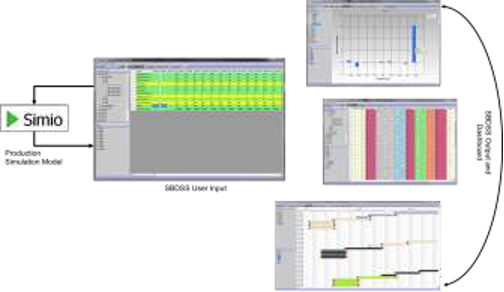Lockheed Martin was awarded the contract for final assembly of the F-35 Joint Strike Fighter, a fifth generation fighter available in three variants for the US Air Force (Conventional Take-off and Landing, CTOL), USMC (Short Take-off and Vertical Landing, STOVL), and US Navy (Carrier-based, CV). The F-35 will initially be built under a series of LRIP (Low Rate Initial Production) contracts, where the number of aircraft nearly doubles with each new contract. It is during the LRIP phase of production that Lockheed Martin will transition their F-35 manufacturing facility from the production rate of three aircraft per month to approximately one aircraft leaving the facility every other day. It is imperative that during this transition period, and into full rate production, that the variability and delays that disrupt performance to the production schedule be mitigated to meet contracted delivery dates.
In this project, a Decision Support System (DSS) was developed and integrated with the Lockheed Martin developed Enterprise Production Model (EPM). The overall objective of the DSS was to provide decision makers with access to relevant production system data and decision variables as they sought to modify production schedules. Furthermore, the DSS executes the EPM in conjunction with an optimization routine to aid decision makers when optimizing values for the decision variables. Lastly, the DSS produces views of pertinent model output in the form of charts, graphs, and tables.
Discrete Event Simulation is a powerful tool for modeling and analyzing production systems to improve throughput and unit cost. However, the ability to rapidly conduct what-if analyses and semi-automatically generate production schedules is limited due to a high level of manual interaction required by simulation software.
In this project, the Simulation-Based Decision Support System (SBDSS) was developed as an intelligent interface to simulation software with the objective of increasing the number of analyses that could be generated. The DSS was integrated with the Enterprise Production Model (EPM), a detailed discrete event simulation model built within Simio simulation software and used to simulate resource requirements in support of future schedules / schedule changes. The SBDSS allows for loading current F-35 production data and aircraft delivery dates. It then iteratively and intelligently exercises the underlying EPM simulation model to create feasible, efficient production resource plans. The tool provides graphical outputs to the analyst and decision makers, which enables them to effectively generate and evaluate the production schedules.

The SBDSS, integrated with EPM, was developed and successfully demonstrated at Lockheed Martin Ft. Worth. The SBDSS software was initially transitioned in FY12Q3 and subsequent releases through FY13Q4. The SBDSS tool has been installed and is being used to demonstrate a paradigm shift between resource planning and scheduling at LMAC: simulation-based resource planning may occur rapidly and proactively to mitigate schedule disruptions.
Implementation of the tool and overall scheduling paradigm is expected in FY14Q4 initially benefiting the JSF program and potentially extending to other Lockheed Martin business units.
Start Date: February 2011
End Date: September 2013
Navy ManTech Investment: $409K
Lockheed Martin, F35 Joint Program Office,
Institute for Manufacturing and Sustainment Technologies